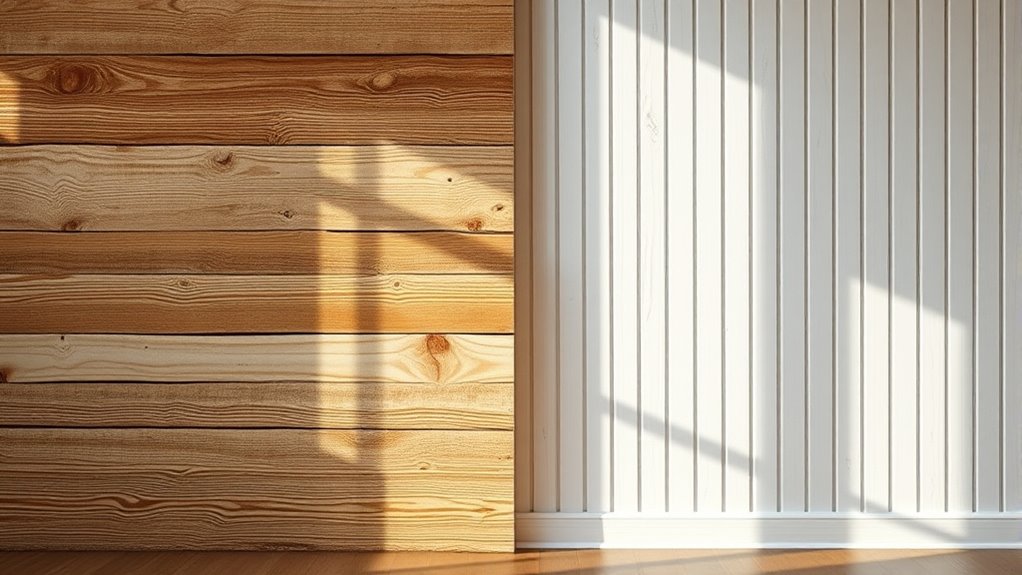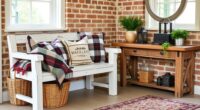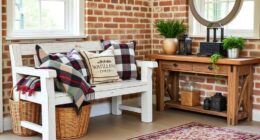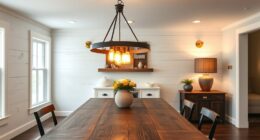If you want an easy, budget-friendly update, shiplap is a great choice because it’s simple to install with wider planks that hide gaps and create a modern look. Beadboard, with its detailed profile, works best when you want a traditional, charming vibe and don’t mind more precise fitting and higher costs. To decide which fits your style and skill level, keep exploring the differences and ideal applications for each option.
Key Takeaways
- Shiplap offers easier installation and a modern, rustic look, ideal for quick, budget-friendly DIY upgrades.
- Beadboard provides a traditional, detailed aesthetic, perfect for classic or cottage-style interiors.
- Shiplap is more cost-effective with wider planks and simple groove systems, suitable for larger areas.
- Beadboard requires precise fitting and is better suited for projects valuing intricate craftsmanship.
- Choose shiplap for a contemporary feel and ease, or beadboard for timeless charm and detailed design.

Are you trying to decide between shiplap and beadboard for your next project? Choosing the right wall paneling can considerably impact the overall look and feel of your space, so it’s important to weigh how each option aligns with your skills and budget. When it comes to DIY installation, shiplap tends to be more straightforward because of its simple design and wider planks. Most shiplap boards feature a groove-and-ledge system that allows you to easily slide each piece into place, making the installation process smoother for beginners. Beadboard, on the other hand, often involves more detailed work, especially if you’re installing the traditional tongue-and-groove style. While some beadboard panels are designed for DIY, they may require more precise measurements and careful fitting to ensure a seamless look.
Shiplap offers easier DIY installation with wider planks and simple groove systems.
Cost comparison is another key factor to contemplate. Generally, shiplap tends to be more affordable, especially if you opt for pine or other softwood options that are readily available at hardware stores. Its wider planks mean you need fewer pieces overall, which can reduce material costs. Additionally, because shiplap panels are often pre-primed or unfinished, you can save money on finishing materials and labor. Beadboard, in contrast, can be a bit pricier, especially if you choose high-quality, solid wood panels. The narrower design means you’ll need more pieces to cover the same area, which can drive up material costs. Plus, beadboard often requires priming and painting, adding to the overall expense and time investment.
In terms of installation, shiplap’s ease of use makes it a popular choice for DIYers seeking quick results without much fuss. Its design minimizes gaps and irregularities, helping you achieve a polished look with less effort. Beadboard, while beautiful and classic, demands more attention to detail during installation, especially if you’re working with tongue-and-groove panels. It also often requires more precise cutting and fitting, which can be challenging if you’re new to DIY projects. Both options can be painted or stained to match your decor, but beadboard’s intricate profile allows for a more traditional, cottage-inspired style, while shiplap offers a more modern, rustic appearance. Additionally, using airless paint sprayers can make finishing these panels quicker and provide a smooth, professional-looking coat.
Ultimately, your choice depends on your project skills, budget, and aesthetic preferences. If you’re after a quick, budget-friendly upgrade that’s easy to install yourself, shiplap might be the better choice. But if you’re aiming for a timeless, detailed look and don’t mind investing extra time and money, beadboard can bring a charming touch to your space.
Frequently Asked Questions
Which Material Is More Eco-Friendly for Wall Paneling?
You’ll find that beadboard is generally more eco-friendly because it often uses sustainable materials and can incorporate recycled content, reducing environmental impact. Shiplap, typically made from solid wood, may have a higher carbon footprint, especially if sourced from non-sustainable forests. To make an even greener choice, look for options made from reclaimed wood or certified sustainable sources, ensuring your wall paneling supports eco-conscious practices.
Can Shiplap or Beadboard Be Painted Multiple Times?
Coincidentally, both shiplap and beadboard can be painted multiple times if you prepare the surface properly. You should start with good surface prep—clean, sand, and prime for better paint adhesion. When it comes to paint durability, choose high-quality paints and apply thin coats. With proper prep and the right paint, you’ll find that both materials can be refreshed repeatedly, maintaining their beauty and protecting your walls over time.
How Do Maintenance Requirements Differ Between Shiplap and Beadboard?
You’ll find that cleaning routines for shiplap are simple, often just a quick wipe with a damp cloth, while beadboard might require more careful dusting in the grooves. Durability considerations show shiplap tends to withstand moisture better, leading to lower maintenance over time. Beadboard edges can chip or warp more easily, so regular inspections and touch-ups may be necessary to keep it looking fresh.
Are There Specific Lighting Effects That Highlight One Over the Other?
You can use lighting effects to enhance the visual impact of shiplap or beadboard, depending on the look you want. For shiplap, try directional or spotlighting to emphasize its horizontal lines and rustic charm. Beadboard benefits from soft, diffuse lighting that highlights its intricate patterns and creates a cozy atmosphere. Experimenting with different lighting angles and intensities helps you draw attention to the unique textures of each, making your space more inviting.
What Are Cost Differences Between Installing Shiplap and Beadboard?
You’ll find shiplap generally costs more, with higher installation expenses due to its wider planks and more labor-intensive process. Beadboard tends to be more budget-friendly, thanks to its narrower panels and simpler installation. The cost comparison shows that beadboard offers a cost-effective option, while shiplap provides a more premium look with slightly increased expenses. Ultimately, your choice depends on your budget and desired aesthetic.
Conclusion
Ultimately, both shiplap and beadboard bring unique charm to your space. Shiplap offers a rustic, modern look with clean lines, perfect for a contemporary vibe. Beadboard, with its classic, detailed design, adds timeless elegance. While shiplap’s simplicity suits casual settings, beadboard elevates traditional interiors. Your choice depends on your style—whether you want a sleek, minimalist feel or a cozy, vintage charm. Either way, you’ll create a stunning feature wall that truly reflects your personality.










